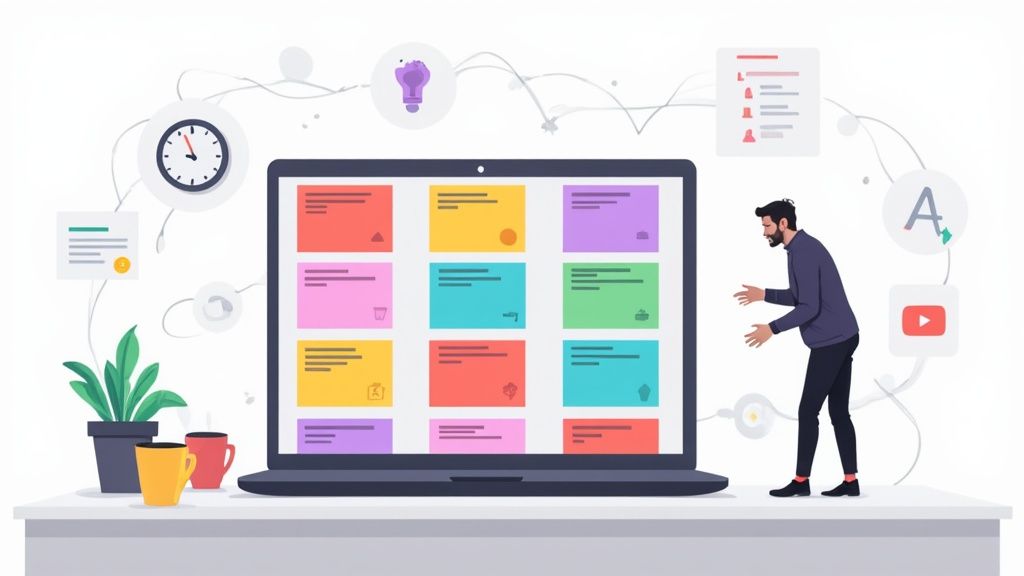How to Grow YouTube Subscribers
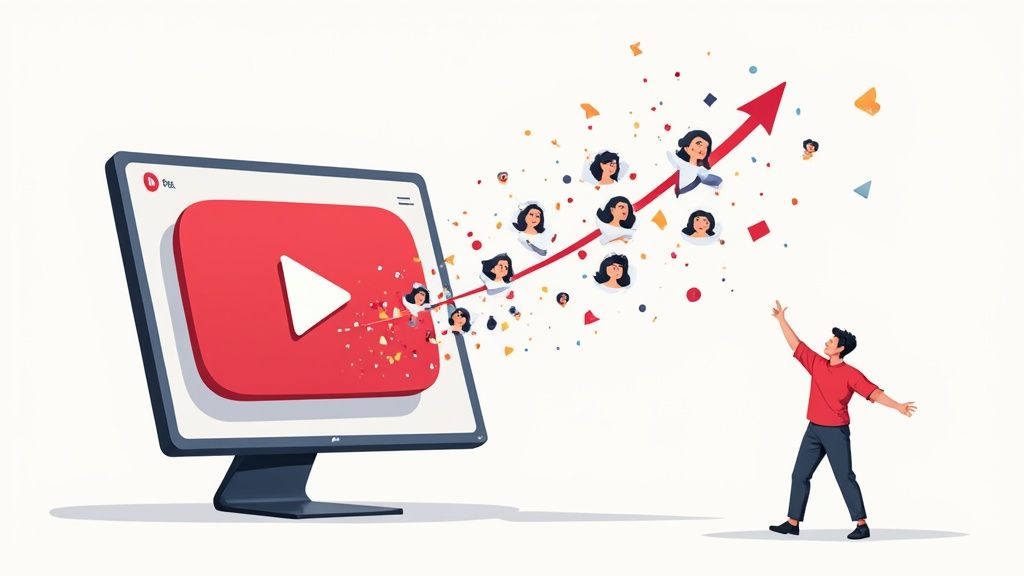
Growing a YouTube channel comes down to two things: making content a very specific group of people will absolutely love, and building a channel that convinces them to stick around. It’s a system. You define your corner of the internet, optimize how your channel looks and feels, and consistently deliver value that turns casual viewers into a real community.
Building Your Channel's Foundation for Growth
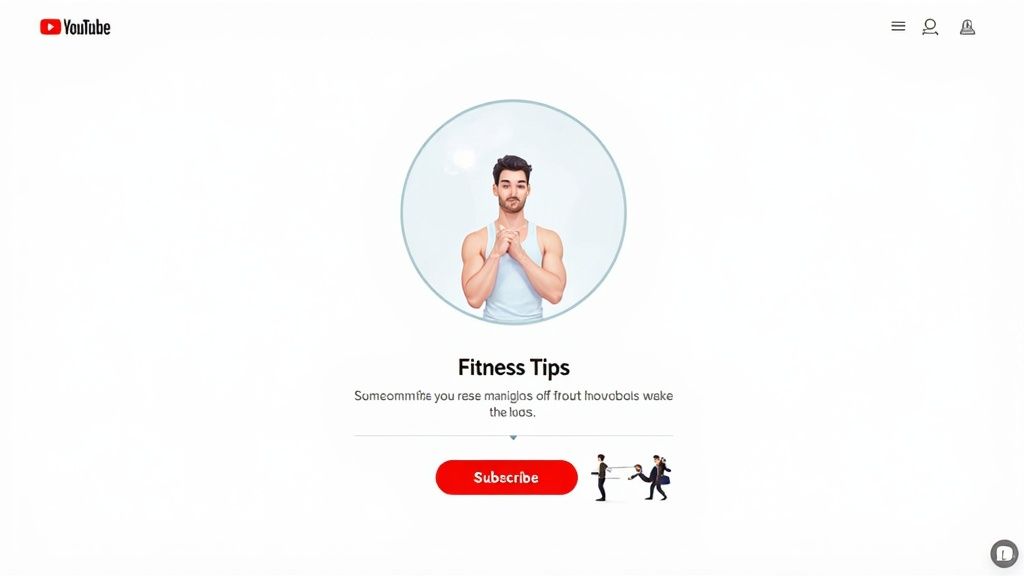
Before you even dream about a flood of new subscribers, you need to build a channel that’s actually built to keep them. This is all about creating a clear identity. One that clicks with first-time visitors and gets them to hit that subscribe button without a second thought. Get this groundwork right, and every video you post from here on out will be far more effective.
The potential audience is just staggering. YouTube has hit around 2.7 billion users globally—that's nearly half of everyone on the internet. And these aren't passive users. Engagement is through the roof, with 62% of U.S. users visiting daily and a wild 92% checking in weekly. This proves one thing: if you give people a good reason to come back, they will. Consistency in your content and your channel's presentation is how you tap into those powerful habits. You can discover more insights about YouTube's user base and its growth here.
Define Your Niche and Value Proposition
First things first: stop trying to appeal to everyone. A channel about "everything" is really a channel about nothing. You need to carve out a specific niche where you can become the go-to expert.
Think of it like this. A viewer is far more likely to subscribe to a channel called "Weekly Keto Meal Prep for Busy Professionals" than a generic "Cooking Channel." The first one makes a clear promise and solves a specific problem. Your job is to find that sweet spot where your passion, your expertise, and what people are actively searching for all overlap.
Your value proposition is the simple, one-sentence answer to the question: "Why should I subscribe to your channel?"
- Bad: "I post videos about marketing." (So does everyone else.)
- Good: "I help solo founders land their first 10 clients with actionable, under-30-minute marketing workflows."
See the difference? The second example is specific, it names the audience, and it promises a tangible result. That kind of clarity is what makes a viewer feel like they’ve finally found what they've been looking for.
Perform a Quick Competitor Analysis
Once you've got a niche in mind, it's time to see who's already playing in that sandbox. Don't let this discourage you—think of it as gathering intel. A quick competitor analysis helps you spot gaps in the market and figure out how to make your videos stand out.
Just head over to YouTube's search bar and start typing in keywords related to your niche. Look at the top-ranking channels and start asking some questions:
- What topics are they covering over and over?
- What video formats are they using (tutorials, reviews, vlogs)?
- What common questions in their comments are going unanswered?
- What’s their branding and visual style like?
You're not looking to copy them. You're looking for an opening. Maybe every channel uses complicated jargon, and you can be the one who breaks it down into simple terms. Perhaps no one is creating short, to-the-point tutorials, and you can fill that need. For example, if you're in the project management space and see everyone using complex software, a channel focused on getting big results with a simple tool like Notion could be a massive differentiator.
To make sure you've covered all your bases, I've put together a quick checklist. Run through this before you upload your first video to ensure your channel is primed for growth right from the start.
The YouTube Growth Foundation Checklist
A quick reference guide to ensure your channel is properly set up to attract and retain subscribers from day one.
| Growth Element | Action Item | Why It Matters |
|---|---|---|
| Clear Niche | Define a specific target audience and content vertical. | A focused channel attracts a dedicated community, making you the go-to expert. |
| Value Proposition | Write a one-sentence channel description that promises a clear outcome. | Instantly tells new visitors why they should subscribe, boosting conversion rates. |
| Competitor Scan | Identify 3-5 top channels in your niche and analyze their strengths/weaknesses. | Helps you find content gaps and differentiate your style and format. |
| Channel Branding | Create a consistent banner, profile picture, and color scheme. | Professional branding builds trust and makes your channel memorable. |
| "About" Page | Fill out your About page with keywords and your value proposition. | Improves your channel's discoverability in YouTube search and tells your story. |
| Channel Trailer | Create a short (<60s) trailer that hooks new viewers and asks them to subscribe. | Your elevator pitch to convert visitors into subscribers automatically. |
Getting these foundational pieces in place isn't justbusywork; it's the strategic framework that supports everything else you do. It ensures that when people discover your content, they have every reason to stick around for more.
Key Takeaway: A strong foundation isn't about having the fanciest gear or the biggest budget. It’s about clarity. A clear niche, a clear value proposition, and a clear understanding of where you fit in the landscape are what will consistently convert viewers into subscribers.
Mastering YouTube SEO for Better Discovery
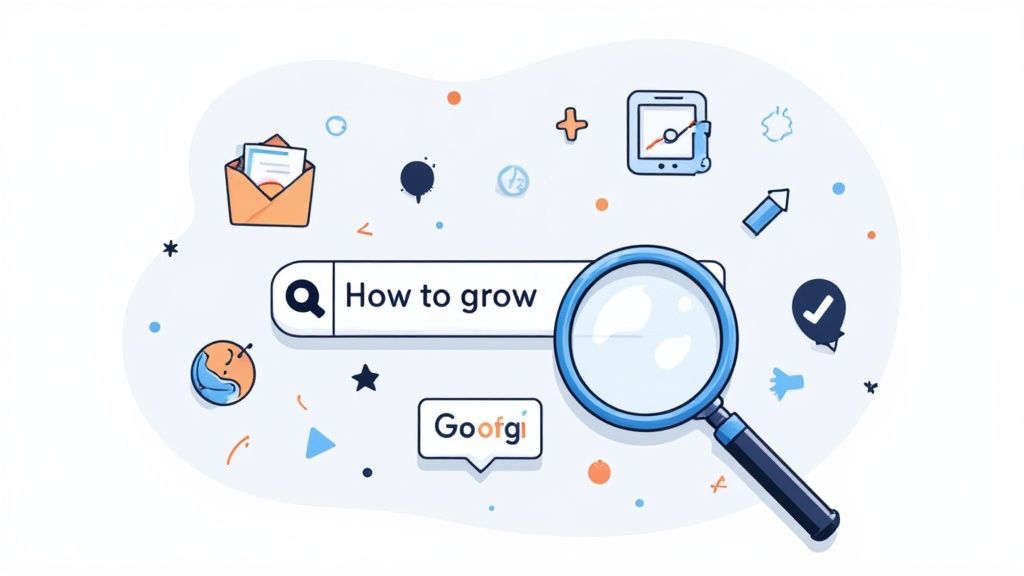
Look, making great videos is only half the job. If your ideal audience can't actually find your content, that subscriber count is going to stay flat. This is where YouTube SEO becomes your secret weapon, turning your channel into a magnet for the right kind of viewers.
Most people forget that YouTube is the world's second-biggest search engine, right behind Google. Every second, people are actively searching for answers, entertainment, and how-to guides. Your mission is to make sure your video is the one they find.
When you nail your optimization, you're essentially giving the YouTube algorithm a clear roadmap. You're telling it exactly what your video is about and who it's for, which leads to better rankings and more of those juicy suggested views.
It all starts with figuring out what your audience is actually typing into that search bar.
Uncovering What Viewers Are Searching For
Good keyword research is the absolute foundation of YouTube SEO. You have to get inside your audience's head and figure out the exact words and phrases they use when they're looking for content like yours. Stop guessing and start using data.
One of the simplest—and most powerful—methods is right there in front of you: the YouTube search bar. Start typing a broad topic from your niche and just watch the autocomplete suggestions. Those aren't random; they're real, popular searches people are making right now.
For instance, type "solo founder," and you'll probably see things like "solo founder daily routine" or "solo founder mistakes to avoid." Boom. Each one is a potential video idea with proven demand.
If you want to go deeper, tools like Frase can help you analyze the top-ranking videos and pull out common questions your audience is asking. If you want to really dig into this process, we have a complete guide on keyword research for small business operations that breaks it all down.
Key Insight: The best video ideas come directly from your audience's search queries. Stop creating content you think they want and start creating content you know they are looking for.
Crafting Titles That Work for Humans and Algorithms
Your video title has two jobs. It needs to contain your target keyword for the algorithm, but it also has to be compelling enough for a real person to click. You have to nail both.
Always try to place your main keyword as close to the beginning of the title as you can. This gives it more weight in YouTube's ranking system. Then, add a human touch that triggers curiosity or promises a clear benefit.
- SEO-focused: "Webflow Tutorial for Beginners"
- Optimized Hybrid: "Webflow Tutorial for Beginners The Only 15-Minute Guide You Need"
See the difference? The second title still has the keyword front and center, but it adds a powerful hook—a promise of speed and efficiency. This combo satisfies the search bots and human psychology, which can dramatically boost your click-through rate.
Writing Descriptions and Using Tags Strategically
Your video description is another prime piece of real estate for SEO. While most viewers won't read the whole thing, you can bet the YouTube algorithm does. The first 2-3 sentences are the most critical because they show up in search results. Make sure to include your primary keyword and a punchy summary right there.
Beyond that intro, use the rest of the description to add more context.
- Secondary Keywords: Sprinkle in related terms and long-tail phrases naturally.
- Timestamps: Break your video into chapters. This improves the viewer experience and can even help your video's key moments show up in Google search results.
- Relevant Links: Point viewers to your website, products, or other social channels.
Tags aren't as powerful as they used to be, but they still help. Think of them as a way to give YouTube extra context. Include your main keyword, a few variations, and some broader category terms.
If your video is on "cold email outreach," your tags could include things like "cold email tips," "sales outreach," "lead generation," and even the names of any tools you mention, like Apollo. This helps your video get recommended in the "suggested videos" sidebar next to related content—a massive driver of views and new subscribers.
Creating Content That Earns Subscriptions
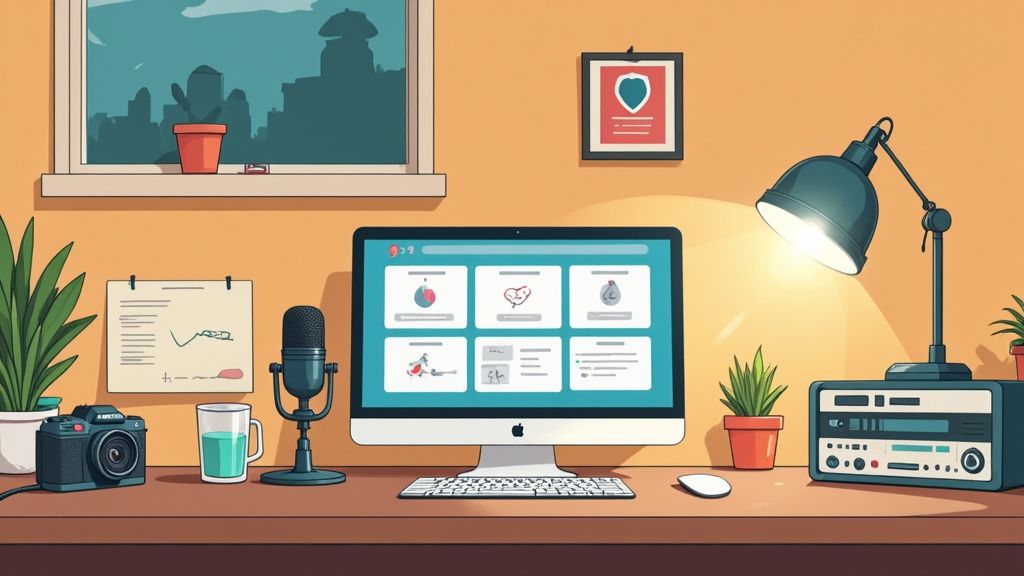
Alright, your channel’s foundation is set and you know the basics of getting discovered. Now comes the real work. Every single video you hit “publish” on is an audition—a direct pitch to a viewer explaining why they should stick around.
It’s not just about dumping information. It’s about crafting an experience so valuable they’d feel like they’re missing out by not subscribing.
This requires a repeatable system for everything from brainstorming ideas to producing content that looks and sounds professional, even when you're a one-person show. Let's break down exactly how to create videos that consistently turn casual viewers into loyal fans.
Generating Endless High-Value Video Ideas
The fear of running out of ideas is real, but it’s completely avoidable if you stop waiting for inspiration and start building a system. The best ideas aren't pulled out of thin air; they're pulled directly from the problems and questions your audience already has.
Your ideation process should be an active hunt for problems to solve. Here are three simple frameworks you can use to build an idea bank that never runs dry:
- The "Problem/Solution" Framework: Find a common pain point in your niche and make your video the direct solution. For instance, if your audience struggles with productivity, a video like "How I Organize My Entire Week in 30 Minutes Using Todoist" is an instant click. It promises a clear, actionable outcome.
- The "Compare and Contrast" Framework: Your audience is constantly weighing options. Help them. A video comparing two popular tools or strategies, like "Webflow vs. WordPress: The Definitive Guide for Solo Founders," positions you as the expert who can bring them clarity.
- The "Process Breakdown" Framework: Take something complex that overwhelms your audience and break it down into a simple, step-by-step workflow. This is gold for tutorials, case studies, or system walkthroughs.
By leaning on these proven formats, you shift your thinking from "what should I make?" to "how can I best solve this for my viewer?" That small change in perspective is the key to creating content people feel they need to subscribe to.
Structuring Videos for Maximum Viewer Retention
Getting the click is only half the battle. Keeping the viewer watching is what truly matters. YouTube's algorithm heavily favors videos with high audience retention because it’s a direct signal that your content is delivering on its promise.
The first 15 seconds are absolutely critical. This is your hook. You have to immediately validate their click and promise them the value they came for.
Key Takeaway: A strong hook isn't just a flashy intro. It's a clear promise. State the problem you're solving, the question you're answering, or the result the viewer will get by the end of the video.
After a solid hook, your content needs to follow a logical path that builds momentum. Even in educational videos, use storytelling. Frame the problem, introduce your content as the solution, and show the transformation or final result. This narrative structure keeps people invested right to the end—a powerful signal to the YouTube algorithm.
Improving Production Quality Without Breaking the Bank
High production value doesn't require a Hollywood budget. In today’s YouTube world, it boils down to two things: clean audio and decent lighting. Viewers will forgive a slightly shaky camera, but they will click away in a heartbeat if they can't hear you clearly.
Your first investment should be a quality USB microphone. It’s the single biggest upgrade you can make to your videos for under $100. Next, focus on lighting. A simple ring light or a couple of softboxes can make even a smartphone camera look fantastic.
Another game-changing tactic, especially for solo operators, is using AI for professional-grade voiceovers. This is a massive shortcut for faceless channels, explainer videos, or tutorials. Tools like Murf.ai can generate incredibly realistic voiceovers, saving you hours of recording and editing. If you're leaning that way, we have a complete guide on how to start a faceless YouTube channel that dives deep into the strategy and tools you'll need.
https://www.unkoa.com/how-to-start-a-faceless-youtube-channel-in-2025-the-ultimate-guide-to-niches-ai-tools-and/
Getting your first 100 subscribers officially places your channel in the top 37% of all creators. Hit 500, and you're ahead of 58% of channels on the platform. These early milestones prove you're already distinguishing yourself from the majority. As you push toward bigger goals like the 100K Silver Play Button, consistently leveling up your content is the only way forward. You can explore more YouTube subscriber growth statistics to see just how these milestones stack up.
Designing Thumbnails That Get The Click
Your thumbnail and title are the gatekeepers to your video. A viewer might love your content, but first, you have to convince them to click. You’re playing a game of milliseconds where a powerful visual decides between a view and a scroll-by.
Think of your thumbnail as a book cover on a crowded shelf. It has to instantly scream the video's value and spark an emotional reaction. A high click-through rate (CTR) is one of the strongest signals you can send the YouTube algorithm, telling it your content is compelling. That leads to more impressions and, you guessed it, more subscribers.
The Psychology of a High-Performing Thumbnail
Great thumbnails aren't just about pretty pictures; they're about strategic visual communication. They tap into predictable psychological triggers to grab attention and ignite curiosity. The goal is to make someone feel like they have to know what's inside.
This usually comes down to a few key elements:
- Visual Hierarchy: The most important thing should be the biggest thing. It could be a face showing a strong emotion, the "after" shot of a transformation, or a completely unexpected object. Guide the viewer's eye exactly where you want it.
- Compelling Color Combinations: Use bright, contrasting colors to pop in a feed that’s often full of muted tones. Blues, oranges, greens, and yellows are known to work especially well. Sticking to a consistent color palette also helps build brand recognition over time.
- Curiosity-Driven Text: Less is more. Keep text to a bare minimum—three to five words, maximum. Use a bold, easy-to-read font. The text should ask a question, state a shocking result, or create an information gap the viewer feels compelled to fill by clicking.
Key Takeaway: The best thumbnails make a clear promise. They tell the viewer exactly what they’ll get, see, or learn, while leaving just enough mystery to make that click irresistible.
Practical Design Advice and Consistent Styling
Good news: you don't need to be a professional graphic designer. Tools like Canva or Pikzels are built specifically for creators, offering templates and features that make the whole process much simpler. If you're weighing your options, check out our detailed comparison of Canva vs Pikzels for solo YouTubers.
When you're designing, think about consistency. Develop a recognizable style with the same fonts, color schemes, and layouts. This makes your videos instantly familiar when they pop up in a subscriber's feed or as a suggested video. A consistent look builds trust and hammers home your channel's brand.
Here’s a simple formula for a winning thumbnail:
- High-Contrast Background: Use a clean, bright, or slightly blurred background that doesn’t compete with the main subject.
- Clear Focal Point: This is often a person's face showing an obvious emotion (surprise, frustration, joy). Faces create an immediate human connection.
- Minimalist Text: Add 2-4 powerful words that support the title and add a layer of intrigue. For example, if your title is "I Tried The 5 AM Morning Routine For 30 Days," the thumbnail text could just be "NEVER AGAIN."
Writing Titles That Create Intrigue Without Clickbait
Your title works in tandem with your thumbnail. The thumbnail grabs their attention; the title closes the deal. The key is to create intrigue without being dishonest. Misleading clickbait is a surefire way to kill your audience retention and signal to YouTube that viewers don't like what they find, which will hurt your channel in the long run.
A great title is specific and promises a clear benefit or outcome. It often includes a number, a strong adjective, or poses a question. Instead of "My Productivity System," try something like "The 3-Step System That Saved Me 10 Hours a Week." It makes a specific, measurable promise that piques interest and pulls in the right audience—funneling more qualified viewers straight toward that subscribe button.
Promoting Your Content and Building Community
Look, hitting "publish" on a video isn't the finish line. It’s the starting gun. Creating a killer video is just the price of admission these days. The real growth—the kind that turns a one-time viewer into a loyal subscriber—happens after you upload.
The channels that really take off aren't just libraries of videos; they're active hubs. They build systems that keep people coming back, spark real conversations, and make viewers feel like they're part of something bigger. This is how you stop being just a content creator and start being a community builder.
Repurpose Your Content for Maximum Reach
Your long-form YouTube video is an absolute content goldmine. If you're just letting it sit on YouTube, you're leaving a massive amount of growth on the table. The secret to smart promotion is slicing up that main video into bite-sized clips for platforms where vertical video is king.
Think about it. Platforms like TikTok, Instagram Reels, and YouTube Shorts are built for discovery. You can take one 15-minute deep-dive video and easily chop it into five, maybe even ten, high-impact short clips. Each one can spotlight a key insight, a funny moment, or a powerful quote from your main video.
This is where tools like Opus Clips become a solo creator's best friend. They use AI to find the juiciest parts of your video, reframe them for a vertical screen, and slap on captions automatically. It’s a way to 10x your content output without 10x-ing your workload, getting your best ideas in front of totally new audiences.
But before anyone even sees your video, they see your thumbnail. This flow chart breaks down how to design thumbnails that actually get clicked.

As you can see, it all connects—from understanding what makes a viewer tick to designing a clean layout and writing a title that sparks curiosity. Each step builds on the last to create something people can't resist clicking.
Repurposing your core video asset is a non-negotiable for growth. To make it easier, here's a simple framework for how to think about spinning one video into multiple pieces of content.
Content Repurposing Strategy Matrix
| Platform | Content Format | Key Objective |
|---|---|---|
| YouTube Shorts | Vertical Clip (15-60s) | Drive discovery and funnel viewers to your main channel. |
| Instagram Reels | Vertical Clip (15-90s) | Build brand personality and engage a visually-driven audience. |
| TikTok | Vertical Clip (15-60s) | Tap into trends and reach a younger, highly engaged demographic. |
| Text Post with Clip | Share professional insights and drive traffic from a business audience. | |
| Twitter (X) | Short Clip / Quote Graphic | Spark conversation with a single powerful takeaway or stat. |
| Blog/Newsletter | Embedded Video | Provide deeper context and capture your audience on your own platform. |
By strategically adapting your video for each platform, you create multiple entry points to your channel, dramatically increasing your potential for new subscribers.
Foster a Thriving Community in the Comments
The comment section is probably the most underrated growth tool you have. Seriously. It's your direct line to your audience, the place where you can forge real connections and show new visitors that you're an active, engaged creator.
Don't just let comments pile up. Make it a ritual to reply to as many as you can, especially in the first few hours after a video goes live. That initial burst of back-and-forth tells the algorithm your video is sparking conversation, which is a huge green flag.
A few easy tactics to try:
- Pin a great comment: Find a comment that adds value, asks a smart question, or perfectly summarizes your video's point. Pin it. This sets the tone for the rest of the discussion.
- Use the heart button liberally: You can't reply to everyone, but you can "heart" their comments. It’s a small gesture that shows people you’ve seen and appreciate their input.
- Ask a direct question: End your videos with a specific question. Not "what do you think?" but something like, "What's the one tool you can't live without?" It gives people a clear prompt to respond to.
Key Insight: An active comment section is pure social proof. When a potential subscriber lands on your video and sees a lively discussion, it signals that your channel has a community worth joining.
Collaborate with Other Creators for Cross-Promotion
Collaborating with creators in your niche is one of the fastest ways to get new subscribers. It’s basically a trusted recommendation. You’re tapping into a pre-built audience that’s already interested in your exact type of content.
Start by looking for channels that are around your size and serve a similar audience. Don't waste your time pitching creators with millions of subs when you're just starting out. Find your peers—the people on the same journey as you.
When you reach out, have a specific idea. Don't send a lazy "wanna collab?" message. Propose something concrete. Maybe you can do a joint interview, or you could each create a video on the same topic and shout each other out. The goal is a true win-win that gives both of your audiences something valuable.
It’s a tough climb, but remember how rare it is to build a substantial audience. As of 2025, only about 619,000 channels have broken the 100,000 subscriber mark—that’s less than 1% of the 115 million channels on the platform. With 90% of all channels having fewer than 1,000 subs, every single step forward is a massive win. You can learn more about YouTube channel subscriber distribution to see just how exclusive these milestones are.
Got questions? Good. Every creator I know has asked these at some point. Let's get them answered so you can get back to building your channel.
How Long Does It Take To Get 1000 Subscribers On YouTube?
Honestly, there's no single answer to this. It could be a few months, or it could take a year—maybe even longer. It all comes down to your niche, how good your videos are, and your consistency.
Instead of staring at the calendar, focus on your system. Are you making genuinely helpful content for a specific person? Are you optimizing every video for search? Are your thumbnails impossible to ignore? That’s what builds a real community and sustainable growth. The subscriber count is just a byproduct of doing those things right, not a goal in itself.
Should I Post Videos Daily Or Weekly On YouTube?
This one's easy: consistency over frequency, every single time.
It's way better to publish one incredible, well-thought-out video each week than to burn yourself out churning out mediocre daily content. The YouTube algorithm loves a predictable schedule it can show to your viewers.
Here's the bottom line: Make the absolute best video you possibly can, and then lock in a schedule your audience can count on. Quality is what turns a random viewer into a loyal subscriber, not how often you hit "publish."
Your job is to become a reliable source of value. Rushing a video out every day just doesn't get you there.
Can You Grow A YouTube Channel Without Showing Your Face?
Absolutely. In fact, "faceless" channels are crushing it in niches like tutorials, gaming, meditation, finance, and product reviews. Your success isn't tied to your face; it's tied to the value you deliver.
But if you're not going to be on camera, you have to nail the other elements. There's no room for error here.
- Your Audio Must Be Flawless: Your voice becomes your brand. It has to be crisp, clear, and professional. This is non-negotiable.
- Visuals Have to Pop: Use high-quality screen recordings, slick animations, b-roll, or sharp graphics to keep people watching.
- Storytelling is Everything: Without a face to connect with, your script and the way you structure information have to do all the heavy lifting to hold attention.
Tools like Murf.ai can even create professional-grade AI voiceovers, making this strategy more accessible than ever. Your brand simply becomes your editing style, your voice, and the quality of your insights.
Does Buying YouTube Subscribers Help Your Channel Grow?
Let me be blunt: No. Buying subscribers is the fastest way to kill your channel.
You're paying for bots or dead accounts that will never watch a video, leave a like, or drop a comment. This creates a massive black hole in your engagement rate, which sends a catastrophic signal to the YouTube algorithm.
It tells YouTube your content is boring, and your reach will get absolutely obliterated in search and recommendations. It's also a direct violation of YouTube's policies and can get your channel deleted permanently, without any warning.
The only path to a successful channel that actually makes money is through authentic, organic growth. You need real viewers who actually care. Anything else is just a shortcut to failure.



